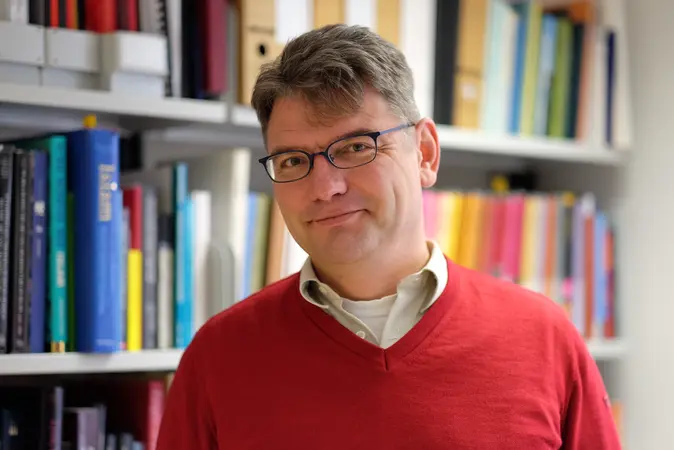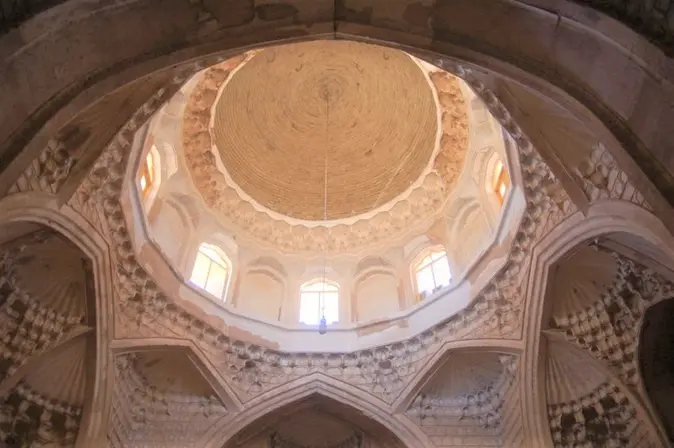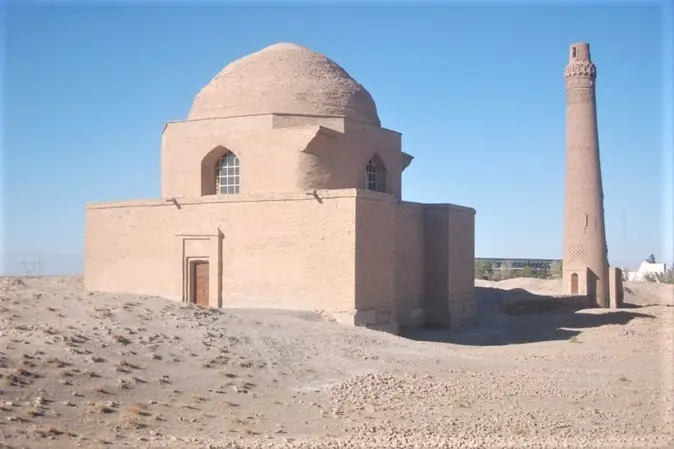Lorenz Korn is an expert on Islamic art history and architecture.
Muqarnas like the ones in the madrasa of vizier Pir Ahmad Khvafi are characteristic of Islamic architecture.
The mausoleum of San Bast features a magnificent domed structure that Korn has been studying in detail.
In the Land of the Rising Sun
If you were to look for Khorasan on a modern map, you’d be out of luck: the so-called “land where the sun rises” was for centuries an influential region in the Islamic Orient. Today, however, only three north-eastern administrative districts of Iran still use Khorasan in their names – a name that once meant so much to this bygone cultural sphere.
So why is it that Khorasan of all places continues to arouse academic interest? In the classical period of the Caliphate, from the 8th to the 11th centuries, the land of the rising sun was regarded as one of the most important provinces. It was situated between the Iranian Plateau and Central Asia and stretched across present-day Afghanistan, parts of Iran and the former Soviet republics of Turkmenistan, Tajikistan and Uzbekistan. “Even for a long time after the 11th century, Khorasan remained a major influence on the cultural geography of the Islamic Orient. Due to the national developments of the early modern period and the colonial expansion, it was divided along political lines and lost its erstwhile significance,” explains Dr. Lorenz Korn, professor of Islamic art and archaeology at the University of Bamberg. Working on his current research project, “Khorasan – Land of the Rising Sun,” he discovered that Khorasan was not only politically and economically influential, but that its architecture and art served as models that greatly impacted the entire Islamic cultural sphere. Today, architects and builders still fall back on architectural elements with roots in the region.
Funding from the Federal Ministry of Education and Research
In the field of Islamic studies, Khorasan is a research topic that is of equally central importance to scholars from Central Asia, Europe and the Americas. With regard to art and archaeology, however, this research area remains relatively unexamined – a gap in research that Korn and his team, together with the Berlin Museum für Islamische Kunst (museum of Islamic art) and the Stuttgart Linden Museum, would like to close. Bamberg is the perfect place to do this: The University of Bamberg is home to Germany’s only professorship dedicated to Islamic art history and archaeology. As part of its humanities-based “Language of Objects” funding initiative, the German Federal Ministry of Education has provided the research project with roughly one million euros.
Approximately 450,000 euros of the grant has gone to Bamberg, where scholars are closely examining various questions of central importance to the project: How did Khorasan’s material culture influence other regions? In what ways are Khorasan’s art and material culture related to other parts of the Muslim world? What innovations originated in the region? Whereas the Bamberg research group is investigating these questions based on their relevance to Khorasani architecture, the cooperative partners in Berlin and Stuttgart are particularly focused on ceramics and metalwork.
An architectural innovation conquers the world
Reserch in Bamberg is primarily focused on determining which architectural developments originated in Khorasan and how they spread throughout the region and the greater Muslim world. The way that a stylistic element of Islamic architecture conquered the world can be traced by the example of the so-called muqarnas. This is a design whose structure resembles a honeycomb, and it is used in architecture as a transitional element between a quadrangular base and a vaulted dome. Research has shown that the muqarnas originated in Khorasan and the element is still being used in modern Islamic architecture: one prime example is the use of the muqarnas in the Hassan II Mosque that was dedicated in Casablanca in 1993. “This reveals that Khorasan was the origin of artistic innovations that have been hugely influential in Islamic art and that play a significant role in architecture to this day,” says Korn.
Another prominent structure on which Korn and the Bamberg research team have focused their work is the mausoleum of the Seljuq Sultan Sanjar. It is a domed structure located in the oasis city of Merv in what is now Turkmenistan. The mausoleum features a gallery whose lower arches are ornamented with moulding, geometric vine ornamentation and various inscriptions. Professor Korn has studied this décor and explains, “These patterns are not only found in Turkmenistan. The same décor exists in other ancient structures in various places like Eastern Iran, on the border of Turkmenistan. There we find the same motifs and designs.” This décor illustrates the regional pervasiveness of material culture within Khorasan. “In the past, there must have been a regional school of architecture with master builders who travelled extensively in the regions beyond Merv.” Due to the fact that the dating of many architectural monuments is based on unreliable sources, inscriptions and certain style elements are particularly important to researchers working to place them chronologically.
Lorenz Korn and his team have until April 2017 to make new discoveries about Khorasan’s architectural monuments. And museum visitors will soon be able to marvel at the research project’s findings: beginning in 2018, they will be included in a permanent exhibition at the partner museum in Stuttgart.
This press release was translated by Benjamin Wilson.


